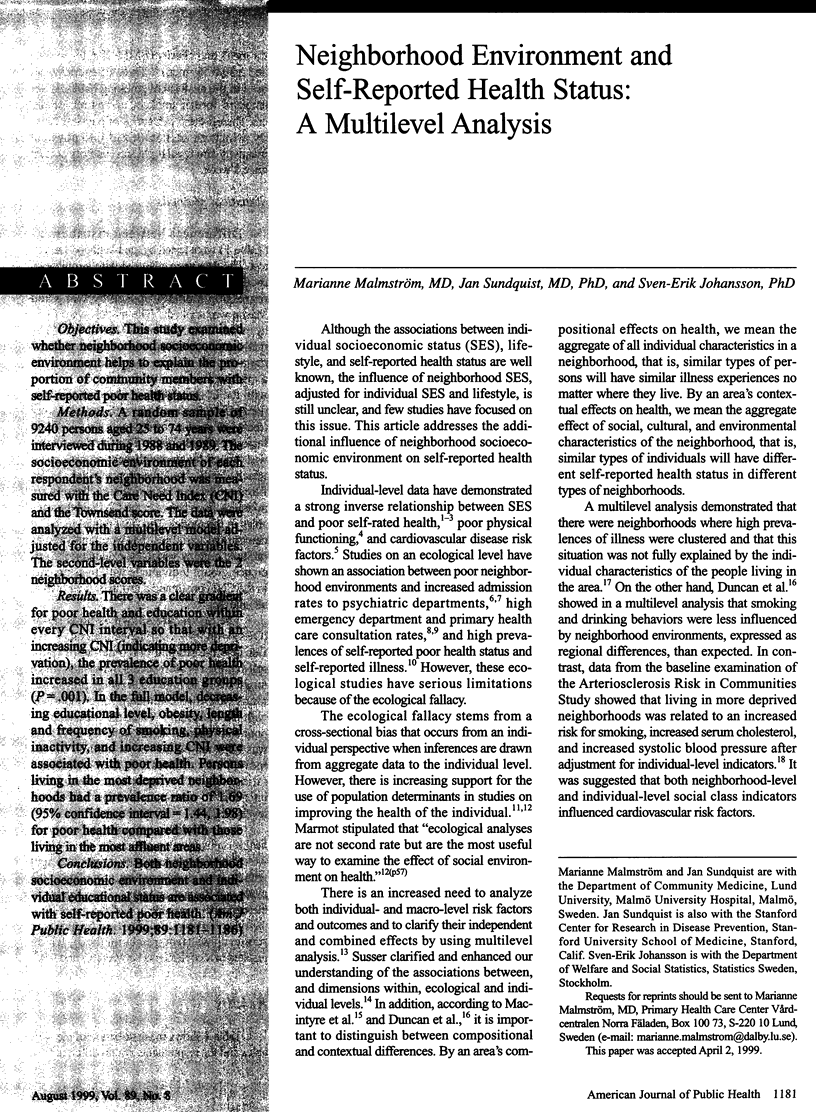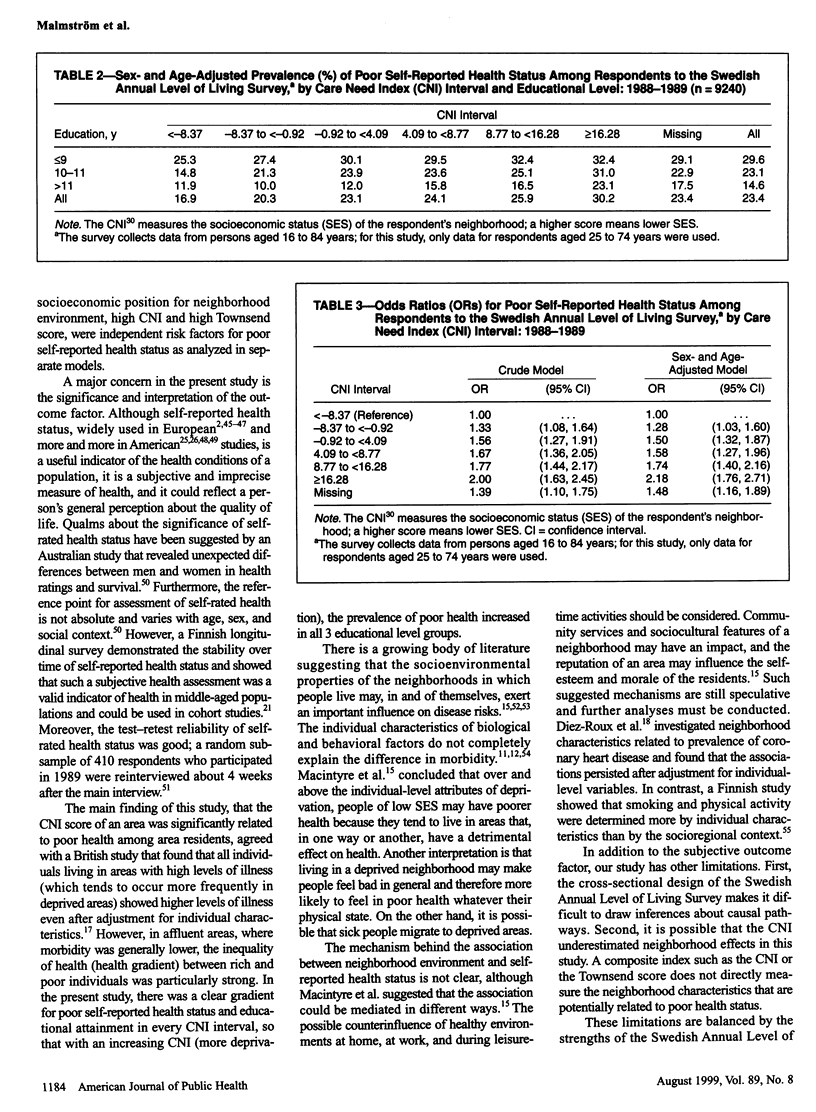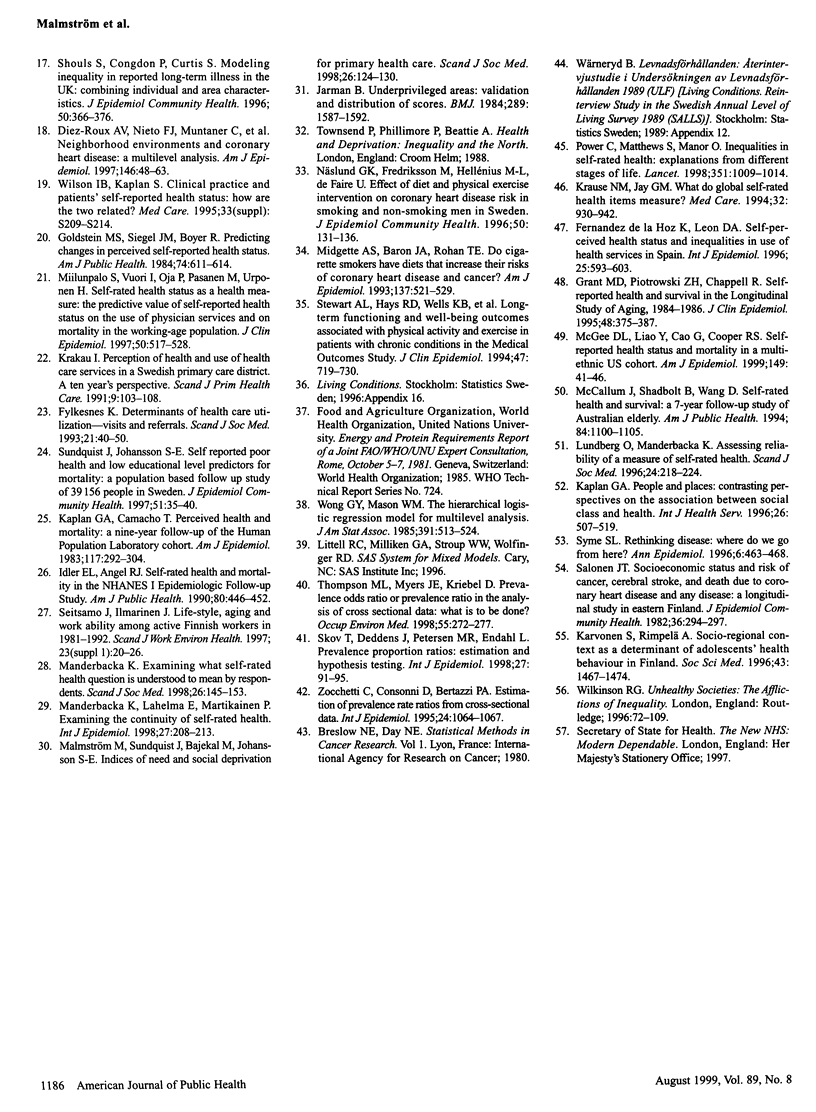Abstract
OBJECTIVES: This study examined whether neighborhood socioeconomic environment helps to explain the proportion of community members with self-reported poor health status. METHODS: A random sample of 9240 persons aged 25 to 74 years were interviewed during 1988 and 1989. The socioeconomic environment of each respondent's neighborhood was measured with the Care Need Index (CNI) and the Townsend score. The data were analyzed with a multilevel model adjusted for the independent variables. The second-level variables were the 2 neighborhood scores. RESULTS: There was a clear gradient for poor health and education within every CNI interval so that with an increasing CNI (indicating more deprivation), the prevalence of poor health increased in all 3 education groups (P = .001). In the full model, decreasing educational level, obesity, length and frequency of smoking, physical inactivity, and increasing CNI were associated with poor health. Persons living in the most deprived neighborhoods had a prevalence ratio of 1.69 (95% confidence interval = 1.44, 1.98) for poor health compared with those living in the most affluent areas. CONCLUSIONS: Both neighborhood socioeconomic environment and individual educational status are associated with self-reported poor health.
Full text
PDF





Selected References
These references are in PubMed. This may not be the complete list of references from this article.
- Andrén K. G., Rosenqvist U. An ecological study of the relationship between risk indicators for social disintegration and use of a somatic emergency department. Soc Sci Med. 1987;25(10):1121–1127. doi: 10.1016/0277-9536(87)90353-4. [DOI] [PubMed] [Google Scholar]
- Diez-Roux A. V., Nieto F. J., Muntaner C., Tyroler H. A., Comstock G. W., Shahar E., Cooper L. S., Watson R. L., Szklo M. Neighborhood environments and coronary heart disease: a multilevel analysis. Am J Epidemiol. 1997 Jul 1;146(1):48–63. doi: 10.1093/oxfordjournals.aje.a009191. [DOI] [PubMed] [Google Scholar]
- Duncan C., Jones K., Moon G. Do places matter? A multi-level analysis of regional variations in health-related behaviour in Britain. Soc Sci Med. 1993 Sep;37(6):725–733. doi: 10.1016/0277-9536(93)90366-c. [DOI] [PubMed] [Google Scholar]
- Eachus J., Williams M., Chan P., Smith G. D., Grainge M., Donovan J., Frankel S. Deprivation and cause specific morbidity: evidence from the Somerset and Avon survey of health. BMJ. 1996 Feb 3;312(7026):287–292. doi: 10.1136/bmj.312.7026.287. [DOI] [PMC free article] [PubMed] [Google Scholar]
- Fernández de la Hoz K., Leon D. A. Self-perceived health status and inequalities in use of health services in Spain. Int J Epidemiol. 1996 Jun;25(3):593–603. doi: 10.1093/ije/25.3.593. [DOI] [PubMed] [Google Scholar]
- Fylkesnes K. Determinants of health care utilization--visits and referrals. Scand J Soc Med. 1993 Mar;21(1):40–50. doi: 10.1177/140349489302100107. [DOI] [PubMed] [Google Scholar]
- Goldstein M. S., Siegel J. M., Boyer R. Predicting changes in perceived health status. Am J Public Health. 1984 Jun;74(6):611–614. doi: 10.2105/ajph.74.6.611. [DOI] [PMC free article] [PubMed] [Google Scholar]
- Grant M. D., Piotrowski Z. H., Chappell R. Self-reported health and survival in the Longitudinal Study of Aging, 1984-1986. J Clin Epidemiol. 1995 Mar;48(3):375–387. doi: 10.1016/0895-4356(94)00143-e. [DOI] [PubMed] [Google Scholar]
- Heistaro S., Vartiainen E., Puska P. Trends in self-rated health in Finland 1972-1992. Prev Med. 1996 Sep-Oct;25(5):625–632. doi: 10.1006/pmed.1996.0098. [DOI] [PubMed] [Google Scholar]
- Hemingway H., Nicholson A., Stafford M., Roberts R., Marmot M. The impact of socioeconomic status on health functioning as assessed by the SF-36 questionnaire: the Whitehall II Study. Am J Public Health. 1997 Sep;87(9):1484–1490. doi: 10.2105/ajph.87.9.1484. [DOI] [PMC free article] [PubMed] [Google Scholar]
- Idler E. L., Angel R. J. Self-rated health and mortality in the NHANES-I Epidemiologic Follow-up Study. Am J Public Health. 1990 Apr;80(4):446–452. doi: 10.2105/ajph.80.4.446. [DOI] [PMC free article] [PubMed] [Google Scholar]
- Jarman B. Underprivileged areas: validation and distribution of scores. Br Med J (Clin Res Ed) 1984 Dec 8;289(6458):1587–1592. doi: 10.1136/bmj.289.6458.1587. [DOI] [PMC free article] [PubMed] [Google Scholar]
- Kaplan G. A., Camacho T. Perceived health and mortality: a nine-year follow-up of the human population laboratory cohort. Am J Epidemiol. 1983 Mar;117(3):292–304. doi: 10.1093/oxfordjournals.aje.a113541. [DOI] [PubMed] [Google Scholar]
- Kaplan G. A. People and places: contrasting perspectives on the association between social class and health. Int J Health Serv. 1996;26(3):507–519. doi: 10.2190/4CUU-7B3G-G4XR-0K0B. [DOI] [PubMed] [Google Scholar]
- Karvonen S., Rimpelä A. Socio-regional context as a determinant of adolescents' health behaviour in Finland. Soc Sci Med. 1996 Nov;43(10):1467–1474. doi: 10.1016/0277-9536(96)00044-5. [DOI] [PubMed] [Google Scholar]
- Krakau I. Perception of health and use of health care services in a Swedish primary care district. A ten year's perspective. Scand J Prim Health Care. 1991 Jun;9(2):103–108. doi: 10.3109/02813439109026592. [DOI] [PubMed] [Google Scholar]
- Krause N. M., Jay G. M. What do global self-rated health items measure? Med Care. 1994 Sep;32(9):930–942. doi: 10.1097/00005650-199409000-00004. [DOI] [PubMed] [Google Scholar]
- Lundberg O., Manderbacka K. Assessing reliability of a measure of self-rated health. Scand J Soc Med. 1996 Sep;24(3):218–224. doi: 10.1177/140349489602400314. [DOI] [PubMed] [Google Scholar]
- Malmström M., Sundquist J., Bajekal M., Johansson S. E. Indices of need and social deprivation for primary health care. Scand J Soc Med. 1998 Jun;26(2):124–130. doi: 10.1177/14034948980260021301. [DOI] [PubMed] [Google Scholar]
- Manderbacka K. Examining what self-rated health question is understood to mean by respondents. Scand J Soc Med. 1998 Jun;26(2):145–153. doi: 10.1177/14034948980260020301. [DOI] [PubMed] [Google Scholar]
- Manderbacka K., Lahelma E., Martikainen P. Examining the continuity of self-rated health. Int J Epidemiol. 1998 Apr;27(2):208–213. doi: 10.1093/ije/27.2.208. [DOI] [PubMed] [Google Scholar]
- Marmot M. G. Improvement of social environment to improve health. Lancet. 1998 Jan 3;351(9095):57–60. doi: 10.1016/S0140-6736(97)08084-7. [DOI] [PubMed] [Google Scholar]
- McCallum J., Shadbolt B., Wang D. Self-rated health and survival: a 7-year follow-up study of Australian elderly. Am J Public Health. 1994 Jul;84(7):1100–1105. doi: 10.2105/ajph.84.7.1100. [DOI] [PMC free article] [PubMed] [Google Scholar]
- McGee D. L., Liao Y., Cao G., Cooper R. S. Self-reported health status and mortality in a multiethnic US cohort. Am J Epidemiol. 1999 Jan 1;149(1):41–46. doi: 10.1093/oxfordjournals.aje.a009725. [DOI] [PubMed] [Google Scholar]
- Midgette A. S., Baron J. A., Rohan T. E. Do cigarette smokers have diets that increase their risks of coronary heart disease and cancer? Am J Epidemiol. 1993 Mar 1;137(5):521–529. doi: 10.1093/oxfordjournals.aje.a116705. [DOI] [PubMed] [Google Scholar]
- Miilunpalo S., Vuori I., Oja P., Pasanen M., Urponen H. Self-rated health status as a health measure: the predictive value of self-reported health status on the use of physician services and on mortality in the working-age population. J Clin Epidemiol. 1997 May;50(5):517–528. doi: 10.1016/s0895-4356(97)00045-0. [DOI] [PubMed] [Google Scholar]
- Näslund G. K., Fredrikson M., Hellénius M. L., de Faire U. Effect of diet and physical exercise intervention programmes on coronary heart disease risk in smoking and non-smoking men in Sweden. J Epidemiol Community Health. 1996 Apr;50(2):131–136. doi: 10.1136/jech.50.2.131. [DOI] [PMC free article] [PubMed] [Google Scholar]
- Power C., Matthews S., Manor O. Inequalities in self-rated health: explanations from different stages of life. Lancet. 1998 Apr 4;351(9108):1009–1014. doi: 10.1016/S0140-6736(97)11082-0. [DOI] [PubMed] [Google Scholar]
- Rahkonen O., Arber S., Lahelma E. Health inequalities in early adulthood: a comparison of young men and women in Britain and Finland. Soc Sci Med. 1995 Jul;41(2):163–171. doi: 10.1016/0277-9536(94)00320-s. [DOI] [PubMed] [Google Scholar]
- Salonen J. T. Socioeconomic status and risk of cancer, cerebral stroke, and death due to coronary heart disease and any disease: a longitudinal study in eastern Finland. J Epidemiol Community Health. 1982 Dec;36(4):294–297. doi: 10.1136/jech.36.4.294. [DOI] [PMC free article] [PubMed] [Google Scholar]
- Seitsamo J., Ilmarinen J. Life-style, aging and work ability among active Finnish workers in 1981-1992. Scand J Work Environ Health. 1997;23 (Suppl 1):20–26. [PubMed] [Google Scholar]
- Shouls S., Congdon P., Curtis S. Modelling inequality in reported long term illness in the UK: combining individual and area characteristics. J Epidemiol Community Health. 1996 Jun;50(3):366–376. doi: 10.1136/jech.50.3.366. [DOI] [PMC free article] [PubMed] [Google Scholar]
- Skov T., Deddens J., Petersen M. R., Endahl L. Prevalence proportion ratios: estimation and hypothesis testing. Int J Epidemiol. 1998 Feb;27(1):91–95. doi: 10.1093/ije/27.1.91. [DOI] [PubMed] [Google Scholar]
- Stewart A. L., Hays R. D., Wells K. B., Rogers W. H., Spritzer K. L., Greenfield S. Long-term functioning and well-being outcomes associated with physical activity and exercise in patients with chronic conditions in the Medical Outcomes Study. J Clin Epidemiol. 1994 Jul;47(7):719–730. doi: 10.1016/0895-4356(94)90169-4. [DOI] [PubMed] [Google Scholar]
- Sundquist J. Ethnicity, social class and health. A population-based study on the influence of social factors on self-reported illness in 223 Latin American refugees, 333 Finnish and 126 south European labour migrants and 841 Swedish controls. Soc Sci Med. 1995 Mar;40(6):777–787. doi: 10.1016/0277-9536(94)00146-k. [DOI] [PubMed] [Google Scholar]
- Sundquist J., Johansson S. E. Self reported poor health and low educational level predictors for mortality: a population based follow up study of 39,156 people in Sweden. J Epidemiol Community Health. 1997 Feb;51(1):35–40. doi: 10.1136/jech.51.1.35. [DOI] [PMC free article] [PubMed] [Google Scholar]
- Susser M. The logic in ecological: I. The logic of analysis. Am J Public Health. 1994 May;84(5):825–829. doi: 10.2105/ajph.84.5.825. [DOI] [PMC free article] [PubMed] [Google Scholar]
- Syme S. L. Rethinking disease: where do we go from here? Ann Epidemiol. 1996 Sep;6(5):463–468. doi: 10.1016/s1047-2797(96)00097-x. [DOI] [PubMed] [Google Scholar]
- Thompson M. L., Myers J. E., Kriebel D. Prevalence odds ratio or prevalence ratio in the analysis of cross sectional data: what is to be done? Occup Environ Med. 1998 Apr;55(4):272–277. doi: 10.1136/oem.55.4.272. [DOI] [PMC free article] [PubMed] [Google Scholar]
- Von Korff M., Koepsell T., Curry S., Diehr P. Multi-level analysis in epidemiologic research on health behaviors and outcomes. Am J Epidemiol. 1992 May 15;135(10):1077–1082. doi: 10.1093/oxfordjournals.aje.a116207. [DOI] [PubMed] [Google Scholar]
- Winkleby M. A., Kraemer H. C., Ahn D. K., Varady A. N. Ethnic and socioeconomic differences in cardiovascular disease risk factors: findings for women from the Third National Health and Nutrition Examination Survey, 1988-1994. JAMA. 1998 Jul 22;280(4):356–362. doi: 10.1001/jama.280.4.356. [DOI] [PubMed] [Google Scholar]
- Zocchetti C., Consonni D., Bertazzi P. A. Estimation of prevalence rate ratios from cross-sectional data. Int J Epidemiol. 1995 Oct;24(5):1064–1067. doi: 10.1093/ije/24.5.1064. [DOI] [PubMed] [Google Scholar]
- de Leon J., Ellis G., Rosen P., Simpson G. M. The test-retest reliability of the Mini-Mental State Examination in chronic schizophrenic patients. Acta Psychiatr Scand. 1993 Sep;88(3):188–192. doi: 10.1111/j.1600-0447.1993.tb03437.x. [DOI] [PubMed] [Google Scholar]


